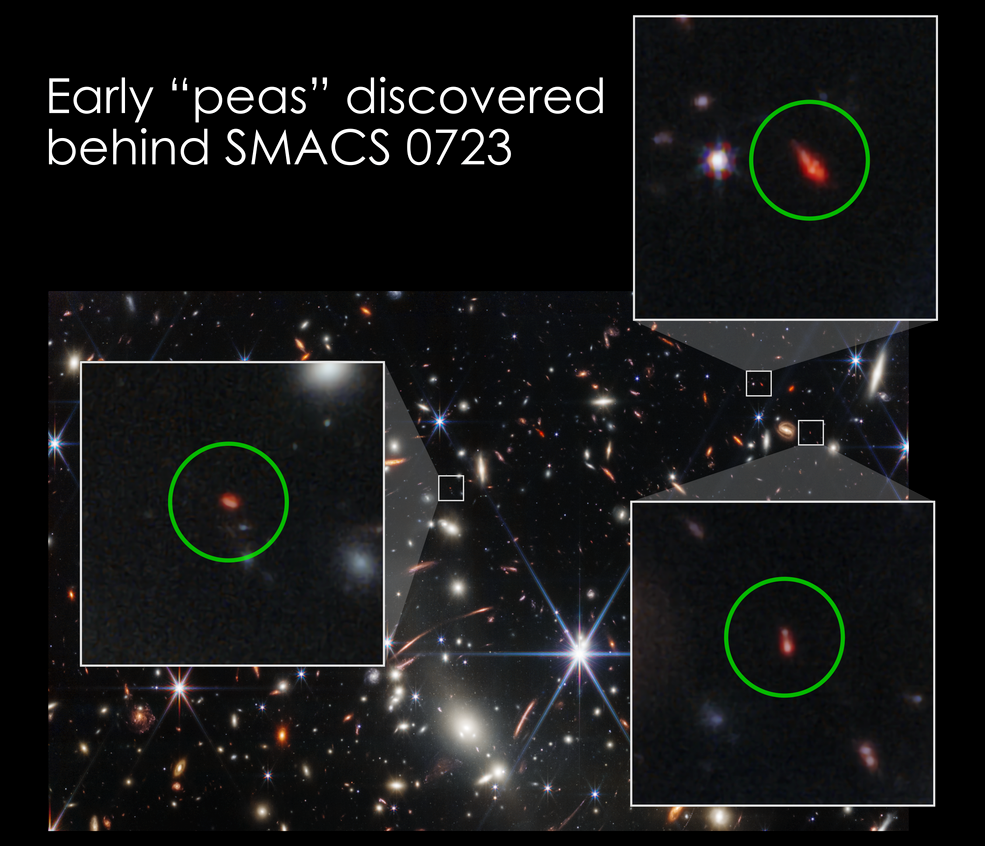At the National Aeronautics and Space Administration (NASA)’s James Webb Space Telescope, a new study of distant galaxies pictured have exhibited the fact that they are exceedingly young and share few outstanding similarities to so-called “green peas,” a unique class of small galaxies present in the cosmic backyard.
 A trio of faint objects (circled) captured in the James Webb Space Telescope’s deep image of the galaxy cluster SMACS 0723 exhibit properties remarkably similar to rare, small galaxies called “green peas” found much closer to home. The cluster’s mass makes it a gravitational lens, which both magnifies and distorts the appearance of background galaxies. We view these early peas as they existed when the universe was about 5% its current age of 13.8 billion years. The farthest pea, at left, contains just 2% the oxygen abundance of a galaxy like our own and might be the most chemically primitive galaxy yet identified. Image Credit: NASA, ESA, CSA, and STScI.
A trio of faint objects (circled) captured in the James Webb Space Telescope’s deep image of the galaxy cluster SMACS 0723 exhibit properties remarkably similar to rare, small galaxies called “green peas” found much closer to home. The cluster’s mass makes it a gravitational lens, which both magnifies and distorts the appearance of background galaxies. We view these early peas as they existed when the universe was about 5% its current age of 13.8 billion years. The farthest pea, at left, contains just 2% the oxygen abundance of a galaxy like our own and might be the most chemically primitive galaxy yet identified. Image Credit: NASA, ESA, CSA, and STScI.
With detailed chemical fingerprints of these early galaxies, we see that they include what might be the most primitive galaxy identified so far. At the same time, we can connect these galaxies from the dawn of the universe to similar ones nearby, which we can study in much greater detail.
James Rhoads, Astrophysicist, Goddard Space Flight Center, National Aeronautics and Space Administration
Rhoads presented the study outcomes at the 241st meeting of the American Astronomical Society in Seattle.
A study explaining the outcomes, headed by Rhoads, was reported in The Astrophysical Journal Letter on January 3rd, 2023.
The discovery of green pea galaxies was done and named in 2009 by volunteers being a part of Galaxy Zoo. It is a project where citizen researchers help categorize galaxies in images, beginning with those from the Sloan Digital Sky Survey.
Peas were highlighted as round, small, unresolved dots with an evident green shade, an impact of both the colors that have been appointed to various filters in the composite images of the survey and a property of the galaxies themselves.
The colors of the Green pea galaxies are uncommon since a sizable fraction of their light arises out of brightly glowing gas clouds. The gases give off light at specific wavelengths—unlike stars, which produce a rainbow-like spectrum of continuous color.
Also, Peas are quite small, normally only around 5,000 light-years across or nearly 5% the size of the Milky Way galaxy.
Peas may be small, but their star-formation activity is unusually intense for their size, so they produce bright ultraviolet light. Thanks to ultraviolet images of green peas from Hubble and ground-based research on early star-forming galaxies, it’s clear that they both share this property.
Keunho Kim, Postdoctoral Researcher and Member, University of Cincinnati
In July 2022, NASA and its collaborators in the Webb mission released the sharpest and deepest infrared image of the diverse universe yet seen, capturing thousands of galaxies in and behind a cluster called SMACS 0723.
The mass of the cluster makes it a gravitational lens, which magnifies and deforms the look of background galaxies.
Among the faintest galaxies that are present behind the cluster was the existence of a trio of small infrared objects that appeared like they could be faraway relatives of green peas. The most detached of these three galaxies was magnified by around ten times, offering considerable support from nature on top of the unparalleled abilities of the telescope.
Webb performed more than just imaging the cluster—its Near-Infrared Spectrograph (NIRSpec) instrument also captured the spectra of chosen galaxies in the scene. While Rhoads and his collaborators analyzed such measurements and further corrected them for the wavelength stretch leading to the expansion of space, they saw characteristic features discharged by hydrogen, neon, and oxygen line up in a stunning resemblance to those observed from nearby green peas.
Besides, the availability of the Webb spectra made it possible to quantify the amount of oxygen present in such cosmic dawn galaxies initially.
Since stars tend to produce energy, they transform lighter elements like helium and hydrogen into heavier ones. When stars blow up or lose their outer layers at the ends of their lives, such heavier elements turn out to be integrated into the gas that develops the next stellar generations, and the process remains. Over cosmic history, stars have helped in the steady enrichment of the universe.
Two of the Webb galaxies consist of oxygen at around 20% of the level present in the Milky Way. They tend to match normal green peas, which still make up below 0.1% of the close galaxies noted by the Sloan survey. The third galaxy studied is even more uncommon.
We’re seeing these objects as they existed up to 13.1 billion years ago, when the universe was about 5% its current age. And we see that they are young galaxies in every sense—full of young stars and glowing gas that contains few chemical products recycled from earlier stars. Indeed, one of them contains just 2% the oxygen of a galaxy like our own and might be the most chemically primitive galaxy yet identified.
Sangeeta Malhotra, Researcher, Goddard Space Flight Center, National Aeronautics and Space Administration
Journal Reference:
Rhoads, J. E., et al. (2022) Finding Peas in the Early Universe with JWST. The Astrophysical Journal Letters. doi.org/10.3847/2041-8213/acaaaf.